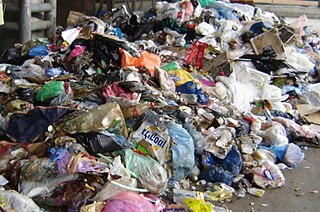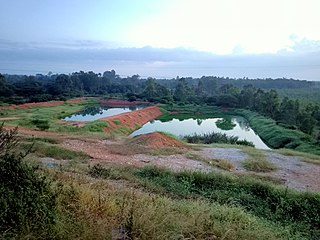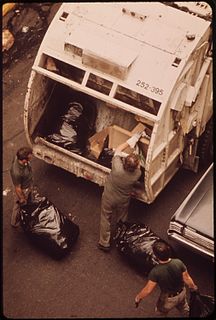Related Research Articles

Waste management includes the processes and actions required to manage waste from its inception to its final disposal. This includes the collection, transport, treatment and disposal of waste, together with monitoring and regulation of the waste management process and waste-related laws, technologies, economic mechanisms.

A landfill site, also known as a tip, dump, rubbish dump, garbage dump, or dumping ground, is a site for the disposal of waste materials. Landfill is the oldest and most common form of waste disposal, although the systematic burial of the waste with daily, intermediate and final covers only began in the 1940s. In the past, refuse was simply left in piles or thrown into pits; in archeology this is known as a midden.

Metro is the regional government for the Oregon portion of the Portland metropolitan area, covering portions of Clackamas, Multnomah, and Washington Counties. It is the only directly elected regional government and metropolitan planning organization in the United States. Metro is responsible for overseeing the Portland region's solid waste system, general planning of land use and transportation, maintaining certain regional parks and natural areas, and operating the Oregon Zoo, Oregon Convention Center, Portland's Centers for the Arts, and the Portland Expo Center. It also distributes money from two voter-approved tax measures: one for homeless services and one for affordable housing.

Zero waste is a set of principles focused on waste prevention that encourages the redesign of resource life cycles so that all products are reused. The goal is for no trash to be sent to landfills, incinerators or the ocean. Currently, only 9% of plastic is recycled. In a zero waste system, material will be reused until the optimum level of consumption is reached. The definition adopted by the Zero Waste International Alliance (ZWIA) is:
Zero Waste: The conservation of all resources by means of responsible production, consumption, reuse and recovery of all products, packaging, and materials, without burning them, and without discharges to land, water or air that threaten the environment or human health.

Illegal dumping, also called fly dumping or fly tipping (UK), is the dumping of waste illegally instead of using an authorized method such as curbside collection or using an authorized rubbish dump. It is the illegal deposit of any waste onto land, including waste dumped or tipped on a site with no license to accept waste. The United States Environmental Protection Agency developed a “profile” of the typical illegal dumper. Characteristics of offenders include local residents, construction and landscaping contractors, waste removers, scrap yard operators, and automobile and tire repair shops.

Municipal solid waste (MSW), commonly known as trash or garbage in the United States and rubbish in Britain, is a waste type consisting of everyday items that are discarded by the public. "Garbage" can also refer specifically to food waste, as in a garbage disposal; the two are sometimes collected separately. In the European Union, the semantic definition is 'mixed municipal waste,' given waste code 20 03 01 in the European Waste Catalog. Although the waste may originate from a number of sources that has nothing to do with a municipality, the traditional role of municipalities in collecting and managing these kinds of waste have produced the particular etymology 'municipal.'

Ariel Sharon Park is an environmental park established on the former Hiriya waste dump located southeast of Tel Aviv, Israel. After accumulating 25 million tons of waste, the facility was shut down in August 1998. It is visible on approach into Ben Gurion International Airport as a flat-topped hill. Three recycling facilities have been established at the foot of the mountain: a waste separation center, a green waste facility that produces mulch and a building materials recycling plant. The waste dump and its surrounding area have been renovated into a large park that is still under construction.

The Keele Valley landfill was the largest landfill in Canada and the third largest in North America during its operation. It was the primary landfill site for the City of Toronto and the regional municipalities of York and Durham from 1983 until 2002, and was owned and operated by the City of Toronto. It was located at the intersection of Keele Street and McNaughton Road in Maple, a community in the northeastern part of the City of Vaughan in Ontario.

Kakani is a Gaunpalika and former village development committee in Nuwakot District in Bagmati Province of central Nepal. At the time of the 1991 Nepal census, the Kakani village development committee administered a population of 7816 living in 1343 individual households.
Waste management in Japan today emphasizes not just the efficient and sanitary collection of waste, but also reduction in waste produced and recycling of waste when possible. This has been influenced by its history, particularly periods of significant economic expansion, as well as its geography as a mountainous country with limited space for landfills. Important forms of waste disposal include incineration, recycling and, to a smaller extent, landfills and land reclamation. Although Japan has made progress since the 1990s in reducing waste produced and encouraging recycling, there is still further progress to be made in reducing reliance on incinerators and the garbage sent to landfills. Challenges also exist in the processing of electronic waste and debris left after natural disasters.

Electronic waste or e-waste in the United States refers to electronic products that have reached the end of their operable lives, and the United States is beginning to address its waste problems with regulations at a state and federal level. Used electronics are the quickest-growing source of waste and can have serious health impacts. The United States is the world leader in producing the most e-waste, followed closely by China; both countries domestically recycle and export e-waste. Only recently has the United States begun to make an effort to start regulating where e-waste goes and how it is disposed of. There is also an economic factor that has an effect on where and how e-waste is disposed of. Electronics are the primary users of precious and special metals, retrieving those metals from electronics can be viewed as important as raw metals may become more scarce

Waste management laws govern the transport, treatment, storage, and disposal of all manner of waste, including municipal solid waste, hazardous waste, and nuclear waste, among many other types. Waste laws are generally designed to minimize or eliminate the uncontrolled dispersal of waste materials into the environment in a manner that may cause ecological or biological harm, and include laws designed to reduce the generation of waste and promote or mandate waste recycling. Regulatory efforts include identifying and categorizing waste types and mandating transport, treatment, storage, and disposal practices.

Waste management in Russia refers to the legislation, actions and processes pertaining to the management of the various waste types encountered throughout the Russian Federation. The basis of legal governance for waste management in Russia at the federal level is outlined through Federal Law No. 89-FZ, which defines waste as “the remains of raw materials, materials, semi-finished products, other articles or products that have been formed in the process of production or consumption as well as the goods (products) that have lost their consumer properties”.
Qoshee also known as Koshe is a large open landfill which receives rubbish and waste from Addis Ababa, the capital of Ethiopia. The name means "dirty" in Amharic.

Mavallipura is a village to the north of Bangalore. A part of the village, about 15 km (9.3 mi) north of the main part of the city was used as an illegal landfill from 2003 to 2015 resulting in an ecological disaster.

New York City's waste management system is a refuse removal system primarily run by the New York City Department of Sanitation (DSNY). The department maintains the waste collection infrastructure and hires public and private contractors who remove the city's waste. This waste, created by New York City's population of more than eight million, can amount to more than ten thousand tons a day.
The Clark Sanitary Landfill is a landfill at the Clark Special Economic Zone in Capas, Tarlac managed and operated by the Metro Clark Waste Management Corp.. It stores and process waste from the Clark area as well as other areas in Central and Northern Luzon.

The Dhobi Khola is a tributary of the Bagmati River which is almost entirely in the district of Kathmandu District. The river originates from Shivapuri Hill and Muhanpokhari, north of Kathmandu Valley, and it is mostly fed by springs and rainfall. Dhobi Khola's mouth is located at Bijuli Bazar where it merges with the Bagmati River.
Banchare Danda landfill is an under construction sanitary landfill site to dispose the solid waste of Kathmandu Valley. It will be used as permanent disposal site after closure of Sisdol landfill. Banchare Danda lies about 27 km from Kathmandu and approximately 1.9km west of existing Sisdole landfill. The Banchare Danda landfill was identified during 2007. The actual construction started in 2019 using 1792 Ropanis of land in Nuwakot and Dhading districts based on the cabinet decision on 3 December 2018 to implement the Integrated Solid Waste Management Project. The landfill site has capacity of about three million cubic metres consisting of two cells. The Cell-1 of the dumping site was ready for use in September 2021 while other parts remains under construction.
The Mbeubeuss Landfill, also Mbeubeuss Rubbish Dump, is a solid waste disposal site in Senegal. It is the main solid waste disposal site for the capital city of Dakar, with a projected population of approximately 4 million people, as of 2022, serving the homes, businesses and industries of that metropolis. The landfill hosts an estimated 4,000 scavengers looking for anything recyclable, primarily plastic. The landfill has been in existence since 1968, however the Senegalese authorities propose to shut it down and set up smaller recycling centers instead.
References
- ↑ "Human waste coexistence in Sisdol landfill site and its impacts". OnlineKhabar English News. 15 March 2020. Archived from the original on 2021-03-29. Retrieved 2021-03-29.
- ↑ Urban Development Ministry321(Unofficial translation)Solid Waste Management of Kathmandu Metropolitan City Environment Audit Report, 2015. Urban Development Ministry.
- ↑ Rasaili, Shahin Sunuwar. "Sisdol: Landfill site holding one-third population's waste". My Republica. Archived from the original on 2021-03-29. Retrieved 2021-03-29.
- ↑ "Environmental Monitoring at Sisdol Landfill Site" (PDF).
{{cite journal}}: Cite journal requires|journal=(help) - ↑ Shrestha, Shankar; Maharjan, Monica; Khatiwada, Nawa Raj; Thapa, Bijay (2020-07-16). "Leachate Characterization and Management at Sisdol Landfill Site in Nepal". Journal of Development Innovations. 4 (1): 119–132. ISSN 2371-9540. Archived from the original on 2020-10-25. Retrieved 2021-03-29.
- ↑ Sen, Sandeep (2019-07-01). "Irate locals obstruct garbage vehicles at Sisdol landfill site". The Himalayan Times. Archived from the original on 2020-11-11. Retrieved 2021-03-29.